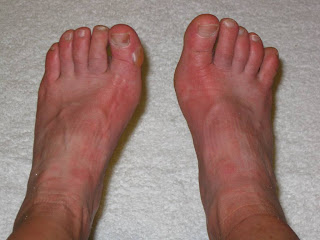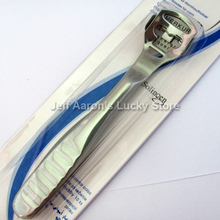Metatarsal Pain
According to STARTHealthCare, three out of four Americans experience foot problems in a lifetime despite the fact that only a small group of individuals are born with foot problems. Calluses are caused by friction, and because feet tend to slide in sandals, calluses build up more quickly in summer.
Other areas that may be affected include the hindfoot (back of the foot) with heel pain from Plantar Fasciitis (inflammation of a ligament extending from the heel to the toes), tendonitis of the Achilles tendon or even bursitis (inflammation of a fluid filled sack at the back of the ankle). RA, as an inflammatory disease, may also include neuropathy (loss of nerve functioning including numbness or muscle weakness), vasculitis (inflammation of the blood vessels), ulcerations (wounds), necrosis of the toes or even gangrene. Even ordinary problems can quickly get worse and lead to serious complications.
Sometimes, the pressure of the corn or callus may cause inflammation, which can result in pain, swelling and redness. The body protects skin tissues from pressure or friction damage by producing an area of hard skin. So unless the cause of the pressure or friction is found and removed, calluses and corns will continue to form. Over-the-counter treatments, such as corn plasters, can damage the healthy surrounding skin if you use them incorrectly. Look at and feel each foot for signs of injury including bruises, blisters, broken or cracked skin, hot or cold areas, corns and calluses, and discolouration. If your eyesight is poor, get someone else to check your feet for you. Tinea is a contagious fungal infection of the skin. It usually develops between the toes and along the arch of the foot.
A clavus is a thickening of the skin due to intermittent pressure and frictional forces. The word clavus has many synonyms and innumerable vernacular terms, some of which are listed in the Table below; these terms describe the related activities that have induced clavus formation. The shape of the hands and feet are important in clavus formation. Specifically, the bony prominences of the metacarpophalangeal and metatarsophalangeal joints often are shaped in such a way as to induce overlying skin friction. Toe deformity, including contractures and claw, hammer, and mallet-shaped toes, may contribute to pathogenesis. First, you had better prepare for a basin of warm water to soak the feet every winter night.
Well, corns (Heloma) are small and round: they also have a hard thickening bit of skin in the middle and are very painful. They usually affect your smaller toes; and wearing poorly fitted shoes can cause excessive friction and rubbing of the skin to form a corn. When people opt to use products containing Aloe Vera, such as gels and creams, they can prevent and remove corns. Common foot problems and nail deformities in our aging population.
Other areas that may be affected include the hindfoot (back of the foot) with heel pain from Plantar Fasciitis (inflammation of a ligament extending from the heel to the toes), tendonitis of the Achilles tendon or even bursitis (inflammation of a fluid filled sack at the back of the ankle). RA, as an inflammatory disease, may also include neuropathy (loss of nerve functioning including numbness or muscle weakness), vasculitis (inflammation of the blood vessels), ulcerations (wounds), necrosis of the toes or even gangrene. Even ordinary problems can quickly get worse and lead to serious complications.
Sometimes, the pressure of the corn or callus may cause inflammation, which can result in pain, swelling and redness. The body protects skin tissues from pressure or friction damage by producing an area of hard skin. So unless the cause of the pressure or friction is found and removed, calluses and corns will continue to form. Over-the-counter treatments, such as corn plasters, can damage the healthy surrounding skin if you use them incorrectly. Look at and feel each foot for signs of injury including bruises, blisters, broken or cracked skin, hot or cold areas, corns and calluses, and discolouration. If your eyesight is poor, get someone else to check your feet for you. Tinea is a contagious fungal infection of the skin. It usually develops between the toes and along the arch of the foot.
A clavus is a thickening of the skin due to intermittent pressure and frictional forces. The word clavus has many synonyms and innumerable vernacular terms, some of which are listed in the Table below; these terms describe the related activities that have induced clavus formation. The shape of the hands and feet are important in clavus formation. Specifically, the bony prominences of the metacarpophalangeal and metatarsophalangeal joints often are shaped in such a way as to induce overlying skin friction. Toe deformity, including contractures and claw, hammer, and mallet-shaped toes, may contribute to pathogenesis. First, you had better prepare for a basin of warm water to soak the feet every winter night.

Well, corns (Heloma) are small and round: they also have a hard thickening bit of skin in the middle and are very painful. They usually affect your smaller toes; and wearing poorly fitted shoes can cause excessive friction and rubbing of the skin to form a corn. When people opt to use products containing Aloe Vera, such as gels and creams, they can prevent and remove corns. Common foot problems and nail deformities in our aging population.
